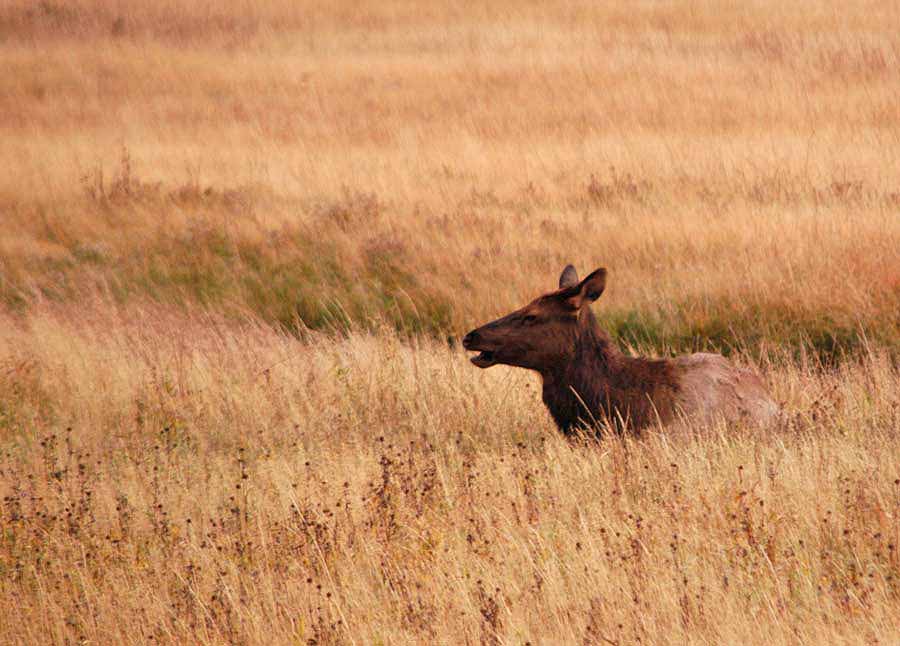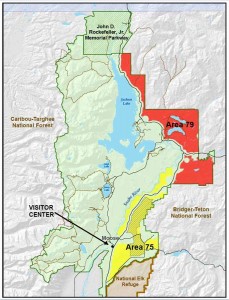
By Ruffin Prevost
JACKSON, WYO. — Although hunting is banned in most national parks, an annual elk hunt aimed at controlling unnaturally high herd sizes will begin Saturday in limited areas within Grand Teton National Park.
Wildlife managers have used federally mandated hunts to help cull the burgeoning elk herds around Grand Teton since the 1950s, and while there is widespread local public support for elk hunts in the park, the practice has been criticized by some.
Grand Teton spokeswoman Jackie Skaggs said in a written statement that the park’s “elk reduction program is an important management tool that differs somewhat from other elk hunting programs in the region.”

The closely monitored and tightly managed hunt has more restrictions than most elk hunting in other areas around Wyoming and the surrounding region. Elk hunters in Grand Teton must carry bear spray and are encouraged to use lead-free ammunition.
Some Jackson Hole wildlife and nature photographers have warned that the hunt habituates grizzly bears to feeding on discarded elk remains, putting humans at risk of surprise encounters with bears.
Park officials have defended the 2007 elk management plan, saying concerns about public safety and lead ammunition are being addressed as the hunts continue. Many environmental and wildlife groups support the hunts as a necessary method for reducing the artificially high elk populations in the area that result from feeding programs.
“The need for the park’s elk reduction program stems partly from an intensive management framework that includes annual winter feeding programs on the National Elk Refuge and in the upper Gros Ventre drainage,” Skaggs said. “Feeding sustains high numbers of elk with unnaturally low mortality rates.”
Some environmental groups and wildlife advocates have called for phasing out artificial feeding of elk around Yellowstone and Grand Teton national parks, saying the practice increases the likelihood of disease outbreaks among elk and creates unbalanced and unnatural population dynamics in the surrounding ecosystems. The complex issue has proven politically and logistically difficult to resolve, and appears beyond the control of any single governing entity or agency.
The annual elk hunts, when needed, were mandated in 1950 by Congress as part of legislation that established Grand Teton boundaries.
Park wildlife officials work closely with counterparts from the Wyoming Department of Game and Fish to monitor herd sizes and determine when hunts are required, and to set quotas for how many elk should be culled.
“Each fall, park rangers intensively monitor and patrol elk reduction areas to ensure compliance with rules and regulations, interpret the elk reduction program to visitors, and provide hunters with information on local conditions associated with this wildlife management policy,” Skaggs said.
Park officials recommend that visitors recreate in areas west of the Snake River that are closed to hunting and advise visitors to wear hunter orange or other bright colors whenever they enter open hunting zones away from park developed areas.
Contact Ruffin Prevost at 307-213-9818 or [email protected].

Grand Teton National Park is knowingly failing to comply with federal law which requires Park hunters to be “qualified and experience hunters” (see portion of legislation below) putting park visitors at extreme and unreasonable risk.
…After the Wyoming Game and Fish Commission and the National Park Service shall have recommended to the Secretary of the Interior and the Governor of Wyoming in any specified year a plan, which has received the joint approval of the Secretary of the Interior and the Governor of Wyoming, calling for the controlled and managed reduction by the method prescribed herein of the number of elk within the Grand Teton National Park established by this Act, and after the Wyoming Game and Fish Commission shall have transmitted to the Secretary of the Interior a list of persons who have elk hunting licenses issued by the State of Wyoming and who are qualified and experienced hunters, on or before July 1 of that year the Secretary of the Interior, without charge, shall cause to be issued orders deputizing the persons whose names appear on such list, in the number specified by the plan, as rangers for the purpose of entering the park and assisting in the controlled reduction plan. Each such qualified hunter, deputized as a ranger, participating in the controlled reduction plan shall be permitted to remove from the park the carcass of the elk he has killed as a part of the plan. (16 U.S.C. § 673c.)
Grand Teton National Park Superintendent Scott and National Park Service Regional Director Wessels both received the following: I was able to secure a 2012 Area 75 elk license, a Wyoming Hunter Education Certification and become a Grand Teton National Park deputized without any QUALIFICATION, without any hunting EXPERIENCE, without ever FIRING A GUN and without ever providing IDENTIFICATION. It will be undisputed negligence on your part in the event a visitor is killed or injured due to circumstances caused by your failure to insure that your deputized rangers are “qualified and experienced hunters.”
Superintendent Scott and Regional Director Wessels are playing Russian roulette with Park visitors lives.
Open Letter to Grand Teton National Park Superintendent Scott:
As you are aware the Greater Yellowstone Ecosystem is in the midst of a severe drought which has resulted in desperate shortages of wildlife food supplies. Grasses that did grow are now dry straw, bushes such as bitter brush are stunted and the annual supply of fall berries simply did not show up. All species of wildlife are scrambling to put on weight for the winter months with minimal food sources available.
Grand Teton National Park’s elk hunt will start at dawn this Saturday resulting in elk gut piles littering the Antelope Flats area and the Snake River bottom stretching from Jackson Dam to Moose. Last year grizzly bears and black bears flocked to the elk gut piles creating a dangerous circumstance which resulted in a hunter being mauled. Bears this year are desperate and will be much more aggressive in their pursuit of food.
This past summer and last year you closed multiple park areas with just the hint of bear activity excepting the park hunt areas which are unquestionably the most dangerous combination of grizzly bears, black bears, elk gut piles, unsuspecting visitors and deputized rangers we now know are not vetted to be “qualified and experienced hunters.” Last fall you were repeatedly made aware of dangerous bear activity in the elk hunt areas but you refused to close those areas putting the bears, the hunters and park visitors at extreme risk.
This is an exceptional year because of the drought and the dangers of mixing bears, hunters, visitors and elk gut piles will be magnified. Please exercise common sense and do your job protecting park visitors and our wildlife. Don’t let the arrogance you demonstrated last fall result in another mauling or death.
Sounds great. I’m glad this was written into the original mandate for Grand Teton. If other parks had such practices they’d have a lot easier time maintaining populations at desired levels.
This hunt makes sense to me. Glad to hear the nut job up top got a tag this year, I hope he gets one!